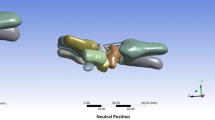Summary
The stability of the carpus is determined by a precise interaction of the osseous and ligamentous elements. The main load of the carpus responsible for the adaptation of concerned tissues is a longitudinal compression caused by the force of the muscles of the forearm with their insertions to the metacarpus and fingers. As a consequence, the proximal row is distracted due to the wedge-shaped form of the hamatum together with the capitatum. It is the function of the mainly oblique orientated ligaments to take these transverse tensional forces, supported by the circular arrangement of the retinacula. Here, the ligaments are described in respect of their precise course into three groups. The distribution of material which is needed for bearing the enormous static and dynamic forces is minimised by the integration in a system of oblique fibre bundles which guaranties that all elements, osseous as well as ligamentous, are involved in the force distribution. This is the prerequisition for the minimalisation of osseous material. On the other hand, damage of only one element can cause severe consequences to the stability of the whole system.
Zusammenfassung
Die Stabilität des Carpus wird vom exakten Zusammenspiel seiner knöchernen und ligamentären Elemente bestimmt. Als hauptsächliche und damit für die Gewebeanpassung verantwortliche Beanspruchung ist eine longitudinale Kompression anzusehen, wie sie durch den Zug der Unterarmmuskeln bei nahezu jeder stärkeren Aktivität entsteht. Durch die keilförmige Anordnung der Knochen der distalen Reihe wird die proximale Reihe einer Querdehnung ausgesetzt, die durch schräge radio- und ulnokarpale Bänder aufgenommen wird. Auch die Retinacula sind als zirkuläre Sicherung aufzufassen. Der Bandapparat wird hier aufgrund des Verlaufes der einzelnen Faserbündel in 3 Gruppen eingeteilt, wobei besonders auf die interossären Bänder Bezug genommen wird. Der zur Aufnahme der beträchtlichen statischen und dynamischen Kräfte notwendige Materialaufwand wird dadurch minimiert, daßüber die schräg zu den Bewegungsebenen eingestellten Faserbündel des komplexen Bandapparats der gesamte Carpus jeweils in den Kraftfluß einbezogen wird. Dies ist die Voraussetzung der weitgehenden Beweglichkeit der Handwurzel. Die strenge funktionelle Interaktion des differenzierten Bandapparats mit den knöchernen Elementen des Carpus bedingt allerdings, daß schon die Schädigung eines einzigen Elements schwerwiegende Folgen für die Stabilität des Gesamtkomplexes hat.
Similar content being viewed by others
Author information
Authors and Affiliations
Rights and permissions
About this article
Cite this article
Moriggl, B., Putz, R. The carpus in the conflict between stability and mobility. Orthopäde 28, 822–832 (1999). https://doi.org/10.1007/PL00003555
Published:
Issue Date:
DOI: https://doi.org/10.1007/PL00003555




